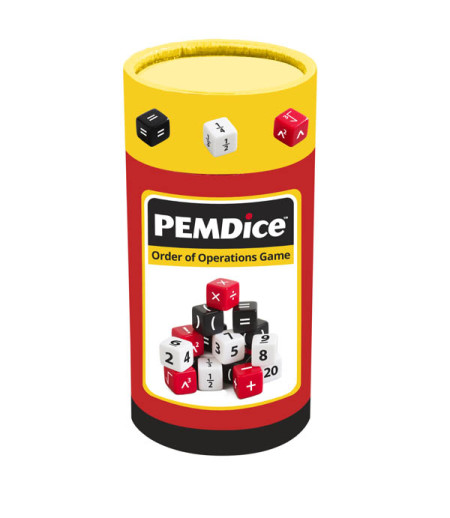We use cookies to make your experience better. To comply with the new e-Privacy directive, we need to ask for your consent to set the cookies. Learn more.
PEMDice Order of Operations Game
Many years ago, you probably learned the order-of-operations acronym “PEMDAS" – Parentheses, Exponents, Multiplication/Division, Addition/Subtraction. It's one of the most important concepts to learn but is often difficult to reinforce. Enter PEMDice! Designed as more of a “game system" than a single-purpose game, the concept is simple: roll a set of 15 operation & numeric dice and create a factual equation. Points are awarded by squaring the number of dice used (so “4x5=20" = 5 dice = 25 points).
But the neat part is just how dynamic the equations can be! Each set of 15 dice consists of 6 numbers (evens 2-6, odds 3-7, numbers 2-7, 8-10, multiples of 10, fractions), 6 operators (addition, subtraction, division, multiplication, square roots, cube roots, powers, factorial), 2 parentheses, and equals. Teachers can add a time limit to encourage students to think faster, award extra points to algebraic operators, or even remove advanced concept dice to teach a younger audience without impacting the game. Other handy “features" include color-coded dice to help students set up the individual pieces of equations, an activity manual explaining how to use the dice, and a sample score sheet. Contains two sets of dice.
Your students need to understand the order or operations (PEMDAS) - PEMDice is a great game to help them practice.
Roll the PEMDice and create equations"just be sure they're correct and follow the mathematical order or operations! Earn points by creating equations that use the most dice.
These unique dice feature numbers, fractions, operations, parentheses and equal
signs. Game includes 30 unique color-coded PEMDice, activity guide with a variety of game options and shaker.
For two students.
| Product Format: | Other |
|---|---|
| Brand: | Didax |
| Grades: | 5-12 |
| EAN/UPC: | 706406118737 |
| Length in Inches: | 6 |
| Width in Inches: | 2.75 |
| Height in Inches: | 2.75 |
| Weight in Pounds: | 0.45 |

